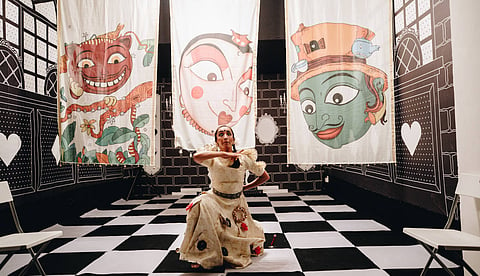India’s premier arts festival, Serendipity, is back on-ground in Goa for its fifth edition. Once again showcasing a curated range of exhibitions, live performances and marketplace, this unique showcase of the arts in India delights and broadens horizons in a way few other initiatives have done.
Amazingly, Covid has proven to only strengthen the Serendipity Arts Festival (SAF). “We did not take a full pandemic-induced break; in fact, we used the time to create the world’s first multidisciplinary digital festival where content was exclusively curated and tailored for digital audiences –making it a truly Internet-ready festival, explains Founder Patron, Sunil Kant Munjal. “500-plus artists were involved in the various projects. This digital festival gained an unprecedented and unexpected response with 42-million direct impressions that have been verified by Google Analytics. We understood how technology could be used to keep the audience engaged, increase viewership, and to empower and support artists. We are using some of these learnings to improve our operational and administrative approach so that the festival becomes more impactful, accessible, and navigable. We have moved our registrations online, which will allow visitors to experience the festival smoothly and plan their visit ahead of reaching the venues.”
Highlighting the festival’s myriad offerings, Smriti Rajgarhia, Director, Serendipity Arts Foundation and Festival, says the festival is taking the arts beyond the white cube and proscenium spaces. “The festival will continue to uphold its fundamental values of sustainability, inclusivity, and accessibility with a marketplace focusing on homegrown, sustainable products and produce, workshops for those with special needs, along with dedicated children’s programmes.”
The festival, spread across 10 venues in Goa’s capital Panaji till 23 December, once again showcases the best of Indian arts across disciplines. “Our experimentation with placemaking will be visible across venues; the idea is to use space not just as a platform but an accessory to the artwork,” emphasizes Munjal, who is also Chairman at Hero Enterprise. "Besides projects being put together by acclaimed curators, there will also be a collaborative exhibition between four galleries; a special archival exhibition, select film screenings, and a host of other projects. In keeping with the changing times, this festival will also feature several projects that will use technology as the basis for artistic practice.”
Vision for the arts
Munjal has been zealous in promoting and reviving the arts ecosystem in the country. “In the coming years, we foresee significant changes in the arts ecosystem, and the festival will continue to bake in these changes. Yet our efforts are but a drop in the ocean; I strongly believe that the SAF-type movements have relevance and there is room for many more to supplement this – so that the impact on arts and culture is strongly felt, and this in turn helps revive some of the lost traditions of the region and gets people more engaged with culture and the arts. I am also aware that there are many fantastic initiatives around the country and each of them – irrespective of scale or focus – are playing a part in bringing arts and culture back into the mainstream. We too, are playing our part in this journey, and would want like-minded people and organisations to join us. Serendipity stands for enhancing India’s soft power; and the festival belongs to everybody.”
For Rajgarhia, India’s heritage of interdisciplinarity in the arts is another facet that the festival bases its heritage on. “Historically, interdisciplinarity has been an integral part of the arts, especially in our region,” she explains. “The festival is recharging these allied sensibilities and counting on the power of collaboration to engage our visitors. The programming this year gives good weightage to interdisciplinarity, which will be further explored by our curators and special project curators through their projects, intersecting dance, drama, music and storytelling, making for a truly interdisciplinary offering. The biggest takeaway that interdisciplinarity as an attribute presents to the audience visiting our festival is that it will give them tools to re-imagine creative boundaries and look at the arts from a renewed perspective.”
The festival’s attention to detail is worth noting. Its avowed underlying themes of sustainability, inclusivity, and accessibility find representation across the festival. “From braille catalogues to maquettes of artworks, to sign language walk-throughs, the accessibility program for the differently abled will include technology that supports easier communication,” points out Munjal.
Community engagement is another focus. “The engagement of the festival with the local community and city is year-long, like activating public spaces through the arts and lending creative inputs to city infrastructure such as sorting stations, etc,” explains Rajgarhia. “The festival also directly and indirectly employs thousands in Panjim and people from other parts of Goa, to support the entire festival at its various fronts, including production, logistics, hospitality industry, local artists, generating income for many.”
For those looking to just let their hair down, there is a lot on offer too, from ‘river ragas’ to aural immersions, music concerts to multimedia presentations, culinary showcases and much more. For a festival that seeks an audience that is age-agnostic, there is a lot to imbibe and revel in.
CURATORS AT SAF
Pramod Kumar KG will highlight the world of specialist books on the art history of India through a uniquely immersive exhibition.
Anjana Somany will enliven the world of craft and its rich traditions of materiality through space-making.
Quasar Thakore Padamsee will helm the Theatre segment which will showcase an eclectic selection of plays.
Prahlad Sukhtankar will curate the Culinary quotient through community meals and a series of workshops decoding food as we know it.
Bickram Ghosh and Ehsaan Noorani will curate the Music section with a wide range of live concerts covering a multi-genre range of classical, folk, indie pop, and rock. Geeta Chandran and Mayuri Upadhya will put together classical, experimental, and contemporary dance performances and workshops this year.
Sudarshan Shetty and Veerangana Solanki will showcase filmmakers to operate and explore the post-pandemic transition from the virtual to the physical.

